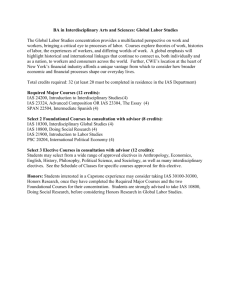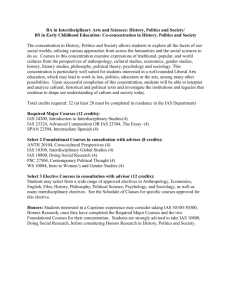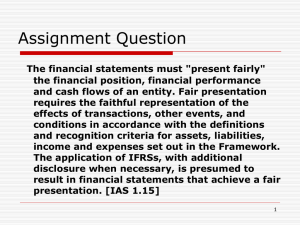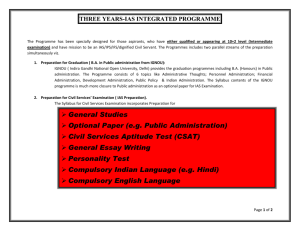IAS Management Options
advertisement
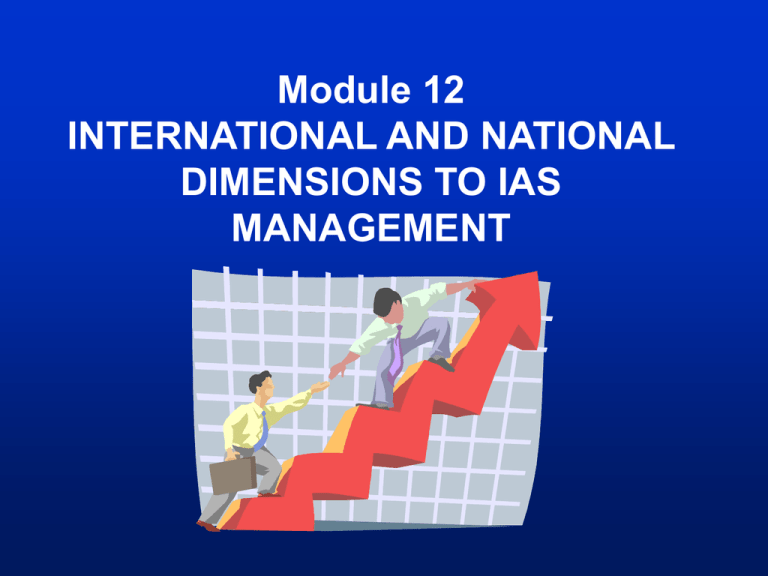
Module 12 INTERNATIONAL AND NATIONAL DIMENSIONS TO IAS MANAGEMENT Conclusion from other Modules: (1) IAS management, public awareness, stakeholder support, institutional mandates, laws and regulations can not be developed or maintained in a vacuum – they influence each other and support each other First Part of Module Conclusion from other Modules of this training (2) International efforts and cooperation will be required to effectively address IAS Second Part of Module In order to to deal with invasive alien species, a National Strategic Framework is required. – National IAS Strategy (“The Plan”) – Implementation (“Carrying out the plan”) – Institutional and Structural arrangements (“Whose job is it?” Who decides?”) – Legislation (and regulations) (“Rights, obligations….”) STRATEGY INSTITUTIONAL IMPLEMENTATION LEGISLATION Different aspects of the Strategic Framework overlap and support each other Building a National Strategic Framework BUILDING BLOCKS FOR NATIONAL STRATEGIC FRAMEWORK Building a National Strategic Framework Structure in this Module: - Developing and implementing a National Strategy - Leadership, Coordination and Cooperation - Legal and Institutional requirements - Approaches DEVELOPING AND IMPLEMENTING A NATIONAL STRATEGY (Building Blocks) •Preliminary Assessment •Task Force •Producing the National Strategy •Operational Arrangements Implementation National Strategy Assessment of situation What alien species and potentially IAS are in your country? What are the pathways? What is at risk? What agencies deal with IAS? What laws and regulations exist? What is the present situation and what constraints are there? Task Force to formulate National Strategy (1)Wide stakeholder participation is crucial to - maximise expert input - maximise support For instance: Government agencies, Primary Producers, other industry and sectors, Environmental NGOs, Regional Government, other relevant Community groups Task Force to formulate National Strategy (2) Analyse all relevant information (3) Determine suitable policies, practices, operational procedures, responsibilities and implementation arrangements (4) Determine who should be the Lead Agency Task Force to formulate National Strategy (5) Produce a Draft National Strategy (6) Circulate the Draft National Strategy widely for comment and input (7) Incorporate input (8) Submit to government for consideration and approval Lead Agency Is an agency with the principal responsibility for operationalising and managing the National Strategy on an ongoing basis ….. ….. in a system of cooperation with other national or local government agencies and consultation with other stakeholders Lead Agency Can be: • Existing agency or • Newly formed entity The most suitable Lead Agency will be different in different countries – depends on: mandate, capacity, resources, national situation….. Lead Agency 1) New Zealand, Ministry of Agriculture and Forestry has been designated the lead agency for all aspects of biosecurity strategy (including biodiversity impacts) 2) Strong coordinating structure e.g. USA National Invasive Species Council Key : structure of cooperation with other agencies where roles and responsibilities are clear and which enables all stakeholders to work effectively together National IAS Strategy • Vision and goals/objectives • Scope (what species, what pathways?, geographic coverage) • Context • Contents: All aspects of dealing with IAS must be covered, including management, leadership, coordination, awareness, legal and institutional, research, funding … It sets “high level” recommendation for actions – not detailed ones Widespread stakeholder involvement is critical Including governmental agencies, industry, primary sectors, NGOs, communities…. National Strategy must create clarity on mandates and responsibilities IMPLEMENTATION OF NATIONAL STRATEGY AND NATIONAL SRATEGIC FRAMEWORK Implementation of a National Strategic Framework will consist of implementing high level recommendations for action as well as the planning and carrying out of day to day activities to address IAS issues. LEADERSHIP AND COOPERATION (Building blocks) • Lead Agency / Invasive Species Committee • Interagency Cooperation • Wide stakeholder involvement Implementation Cooperation Leadership & Coordination National Strategy Lead Agency The main obligation and responsibility for the implementation and ongoing management of the National Strategy and other components of the national framework usually falls on a lead agency in a system of cooperation with other national or local government agencies and consultation with other stakeholders • “A priority action is to establish national IAS Committees (i.e. with full sectoral representation) and national IAS focal points in countries that do not already have them. The Committee should supervise the implementation of the Strategies/Plans and set IAS priorities and responsibilities such as identifying key organisations to lead on specific IAS issues in each country.” Statement by delegates to Austral Pacific Workshop (GISP). Honolulu, October 2002 INTERAGENCY COOPERATION • Clarity of mandates • Clarity of decision making • Competition for funding should be avoided • A decision-making systems to resolve potential conflicts of interest • Good information flow between agencies • Good will and understanding of a common goal Wide Stakeholder involvement • Advisory role in developing Strategy • Involvement in the implementation of IAS management , for example: • Consultation in risk analysis • Development of voluntary guidelines or codes of conducts relating to their sector • Stakeholder Involvement in the implementation of IAS management, e.g. • • • • Participation in surveillance Community led restoration programmes Community led eradication or control programmes Awareness raising and education • Leadership, Coordination and Cooperation are key building blocks for a National Strategic Framework. • It will depend on the country’s situation which Agency may be the best suited to be a Lead Agency. • National IAS Committees could be a good first step towards a Strategic Framework • Interagency Cooperation will require goodwill and understanding of the common goals • Wide stakeholder involvement is critical for the success of a Strategic Framework NATIONAL LEGAL & INSTITUTIONAL FRAMEWORK (Building Block) Legal & Institutional Implementation Cooperation Leadership & Coordination National Strategy • Law is used to implement policy objectives and determine principles, standards and procedures to achieve them • Legal and Institutional systems underpin the mandate to act to address IAS Establishing efficient institutions is one of the most important roles of legislation, though this is often underestimated Key Requirements for National Legal frameworks • Terminology and Definitions • Geographical coverage – All ecosystems – Species native in one part of country and invasive in another part of country (e.g. hedgehogs in Scotland) – Vulnerable and valuable areas Key Requirements for National Legal frameworks • Species coverage – No taxonomic groups omitted – IAS with impacts on primary production, livelihoods, biodiversity, health,…. Key Requirements for National Legal frameworks • Management – – – – – Prevention Early Detection /Rapid response Eradication Control Mitigation of impacts Remember… Where proposed biological control agents are alien species, the full process of risk analysis should apply to them, as for any other proposed intentional introduction of an alien species Legislation must exclude alien species from automatic protection APPROACHES (Building Block) Approaches Legal & Institutional Implementation Cooperation Leadership & Coordination National Strategy Regional and other transboundary approach • IAS do not recognise country borders… – Formalised Regional Strategies – Regional Action Plans – Transboundary Cooperation INTEGRATING IAS STRATEGIES INTO OTHER NATIONAL STRATEGIC ISSUES • • • • Development of biodiversity strategies Poverty alleviation strategies Sustainable development strategies EIA for large engineering works (e.g. canals, tunnels, etc.) • Protected Areas Management Plans SUPPORTING RESTORATION AND APPRECIATION OF NATIVE BIODIVERSITY Invasive species control and reforestation initiative (in partnership with local leaders ), school growing and planting native trees,…..(National Park America Samoa) Using and encouraging native species as an alternative Mekong River Commission (MRC) Fisheries Programme: promotion of aquaculture of Indigenous Mekong fish species Promotion of native plants for disturbed lands, Alberta (Canada) Any use of native species as an alternative to using alien species must be done in the context of sustainable use. Using and encouraging native species as an alternative • • • • • • Gardening Erosion control Developing aquaculture Stocking of rivers and ponds Forestry Aid and development assistance CONTROLS ON DOMESTIC MOVEMENT OF SPECIES PRIORITISING – Risk Analysis PRECAUTION – Precautionary measures are advocated, required or allowed by several international instruments, – Precaution is especially relevant in the context of IAS with biodiversity impacts, because of the ecological complexity involved. INDIVIDUAL CONTRIBUTIONS….. There is always something you can do There is always something you can do CONCLUSIONS Approaches Legal / Institutional Implementation Cooperation Leadership and coordination National Strategy STRATEGIC FRAMEWORK!! Approaches Legal / Institutional Implementation Cooperation Leadership and coordination National Strategy Prevention Early Detection / Rapid response Eradication Control Mitigation Awareness Education Research STRATEGY IMPLEMENTATION LEGISLATION INSTITUTIONAL Funding Etc….. CONCLUSIONS INTERNATIONAL INSTRUMENTS, INITIATIVES AND PROGRAMMES ON IAS REGIONAL SPREAD OF IAS • IAS, once introduced, can spread to neighbouring countries (e.g. Cactoblastis cactorum ) SUMMARY: WHY INTERNATIONAL APPROACH IS REQUIRED 1) MAGNITUDE OF THREAT (Global scale) 2) NEED FOR INFORMATION SHARING: • “usual suspects” – shared problem species • Prior invasiveness – early warning elsewhere 3) NEED FOR MANAGEMENT COOPERATION • IAS in one country can spread to neighbours • Shared IAS • Capacity building 4) GLOBAL TRADE ASPECTS • Cause: movement of huge amount of species outside native range (intentional, unintentional) • Where prevention requires trade restrictions, must be consistent with WTO/SPS…. INTERNATIONAL INSTRUMENTS • • • • • • • • • • The Convention on Biological Diversity (CBD) RAMSAR The International Plant Protection Convention (IPPC) Office International des Epizooties (OIE) The World Health Organization (WHO) IMO GLOBALLAST International Civil Aviation Organization Technical Guidance for Fisheries and Aquaculture Relationship of existing instruments with the multilateral trading system INTERNATIONAL PROGRAMMES AND INITIATIVES • • • • IAS and sustainable development programmes GLOBAL INVASIVE SPECIES PROGRAMME (GISP) WHAT GISP OFFERS COOPERATIVE INITIATIVE ON IAS ON ISLANDS (CII) • International Cooperation between peers • GISP Partners • Regional Cooperation


